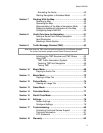Delphi NAV200
6
Section 1 About GPS / NAV 200 Introduction
The Global Positioning System (GPS) is a network of satellites launched by the
U.S. military beginning in the1970s. The satellites continuously transmit accurate
time and position information, which is freely used by commercial and military
applications worldwide. GPS receivers, such as Delphi NAV200, are designed to
pick up the high-frequency radio signals from these satellites and use the
information to help determine your exact location. Today, there are many
applications that use GPS—from marine to automotive, aviation, and military.
There are 24 satellites in total, orbiting approximately 12,000 miles above the
Earth. While a GPS receiver can detect signals from up to 12 satellites at any
one time, only three are needed to provide the two-dimensional position (latitude
and longitude), or “fix,” that is required for vehicle and marine navigation
systems. Aviation applications also need altitude, and therefore need information
from at least four satellites.
The Delphi NAV200 is designed specifically to use the continuous stream of GPS
information to help find your current position and to calculate the best route to
your desired destination using the road maps stored in its memory. With voice
and visual commands, the Delphi NAV200 helps guide you to your destination.
For best results when using Delphi NAV200:
• When the Delphi NAV200 is connected to power for the first time, leave it
connected for about two hours to charge the battery.
• Plan your route before your journey. If you need to set up a new itinerary
en route, safely park your vehicle before making changes.
• GPS signals cannot pass through solid materials other than glass. So
when you are inside a building or tunnel, GPS may not be available.
Likewise, signal reception can be affected by overhead cover such as
trees. Wireless devices may also interfere with signals, causing variable
reception.
• While the Delphi NAV200 can be operated by finger touch, more precise
control can be achieved by using the stylus. Do not use other sharp
objects, which can damage the LCD screen.
• Never clean the Delphi NAV200 with the power on. Use a soft, lint-free
cloth moistened with water to wipe the screen and the exterior. Do not use
paper towels to clean the screen. Do not place anything on top of the
Delphi NAV200. Do not drop the Delphi NAV200 or subject it to severe
shock.


















